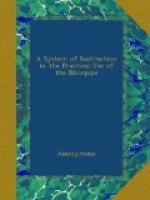* * * * *
The following metals, or their compounds, are reduced when fused with soda on charcoal, in the flame of reduction. They are reduced to metallic particles, but give no incrustation, viz. nickel, cobalt, iron, tin, copper, gold, silver, platinum, tungsten, and molybdenum.
The particles of iron, nickel, and cobalt, it should be borne in mind, are attracted by the magnet.
The following substances are neither fused nor reduced in soda, viz. alumina, magnesia, lime, baryta, strontia, the oxide of uranium, the oxides of cerium, zirconia, tantalic acid, thorina, glucina, and yttria. Neither are the alkalies, as they sink into the charcoal. The carbonates of the earths, strontia, and baryta fuse.
* * * * *
Part III
SPECIAL REACTIONS; OR, THE BEHAVIOR OF SUBSTANCES BEFORE THE BLOWPIPE.
Analytical chemistry may be termed the art of converting the unknown constituents of substances, by means of certain operations, into new combinations which we recognize through the physical and chemical properties which they manifest.
It is, therefore, indispensably necessary, not only to be cognizant of the peculiar conditions by which these operations can be effected, but it is absolutely necessary to be acquainted with the forms and combinations of the resulting product, and with every modification which may be produced by altering the conditions of the analysis.
We shall first give the behavior of simple substances before the blowpipe; and the student should study this part thoroughly, by repeating each reaction, so that he can acquire a knowledge of the color, form, and physical properties in general, of the resulting combination. There is nothing, perhaps, which will contribute more readily to the progress of the pupil, than thorough practice with the reactions recommended in this part of the work, for when once the student shall have acquired a practical eye in the discernment of the peculiar appearances of substances after they have undergone the decompositions produced by the strong heat of the blowpipe flame, together with the reactions incident to these changes, then he will have greatly progressed in his study, and the rest will be comparatively simple.
A. METALLIC OXIDES.
GROUP FIRST.—THE ALKALIES: POTASSA, SODA, AMMONIA, AND LITHIA.
The alkalies, in their pure, or carbonated state, render reddened litmus paper blue. This is likewise the case with the sulphides of the alkalies. The neutral salts of the alkalies, formed with the strong acids, do not change litmus paper, but the salts formed with the weak acids, render the red litmus paper blue; for instance, the alkaline salts with boracic acid. Fused with borax, soda, or microcosmic salt, they give a clear bead. The alkalies and their salts melt at a low red heat. The alkalies cannot be reduced to the metallic state before the blowpipe. They are not volatile when red hot, except the alkali ammonia, but they are volatile at a white heat.




